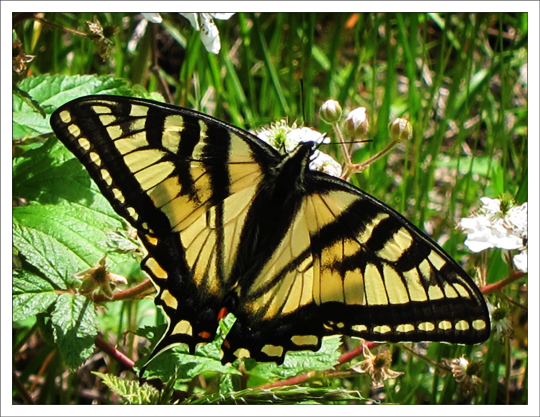Butterflies of the Adirondack Mountains:
Canadian Tiger Swallowtail (Papilio canadensis)
 Butterflies of the Adirondacks: Canadian Tiger Swallowtail near the Paul Smiths VIC Butterfly House (9 June 2012)
Butterflies of the Adirondacks: Canadian Tiger Swallowtail near the Paul Smiths VIC Butterfly House (9 June 2012)
| This page is no longer being updated. For an updated version of this material, see: Canadian Tiger Swallowtail (Papilio canadensis). |
The Canadian Tiger Swallowtail (Papilio canadensis) is a large butterfly with distinctive yellow and black coloring that may be seen in the Adirondack Mountains in upstate New York in early summer. It is a member of the family Papilionidae (Swallowtails), named for the tail-like projections on their hind wings, resembling the tails of swallows. [1]
Seen from above, the Canadian Tiger Swallowtail has a yellow ground color with wide, black tiger stripes. [2] The underside is yellow and often has an over-scaling or orange and black.[3] This butterfly has an average wingspan of 2.9 inches.[4]
The Canadian Tiger Swallowtail is similar to the Eastern Tiger Swallowtail, which is somewhat larger and occurs south of the Adirondack Mountains. [5] [6] Earlier sources refer to the Canadian Tiger Swallowtail as a subspecies. [7] [8] The Canadian Tiger Swallowtail was recognized as a separate species in the early 1990s.[9] [10] The two are closely related and hybrids reportedly occur in central New England. Canadian Tiger Swallowtails can survive in colder winters than Eastern Tiger Swallowtails and experience higher mortality when exposed to heat. In contrast to Eastern Swallowtails, Canadian Tiger Swallowtails rarely produce dark females. [11] [12] [13]
The eggs of the Canadian Tiger Swallowtail are smooth and green. Immature caterpillars resemble bird droppings. [14] Mature caterpillars are dark green with two large eye spots, creating a snake-like profile. [15] [16] Caterpillar hosts include the leaves of birch, aspen and black cherry. [17] [18] [19]
Adult Canadian Tiger Swallowtails subsist on nectar from flowers. [20] The Canadian Tiger Swallowtail is an enthusiastic mud-puddler; at times hundreds may be seen gathered at the same small puddle. [21]
 Butterflies of the Adirondacks: Canadian Tiger Swallowtail in the Paul Smiths VIC Butterfly House (9 June 2012)
Butterflies of the Adirondacks: Canadian Tiger Swallowtail in the Paul Smiths VIC Butterfly House (9 June 2012)
The range of the Canadian Tiger Swallowtail includes the northern portions of the North American continent from central Alaska across Canada and the northern Great Lakes states south to northern New York State (including the Adirondack Park) and northern New England. [22] [23] [24] Its habitat includes northern deciduous and mixed deciduous-coniferous woodlands, wooded suburban areas, and forest edges. [25] [26] [27] [28]
The flight period for the Canadian Tiger Swallowtail is from mid-May to late July, depending on latitude.[29] [30] The Canadian Tiger Swallowtail's flight period in the Adirondack Mountains has not been established. However, most sightings for the Adirondack Park reported in the North American Butterfly Association data base, [31] the BugGuide data base,[32] the INaturalist data base, [33] and the Yahoo New York State Butterfly Group [34] are in very late May and June. During the summer of 2012, Canadian Tiger Swallowtails were seen in the Paul Smiths VIC Native Species Butterfly House and in the adjacent Butterfly Garden in June. [35]
References
- Susan Grimm Hanley. Interpretive Naturalist, Paul Smith's College Native Species Butterfly House. Species Logbooks.
- North American Butterfly Association. Sightings Archive.
- Butterflies and Moths of North American. Species Profiles. Confirmed sightings: 6/9/12; 6/9/12; 6/14/12; 6/16/12
- Government of Canada. Canadian Biodiversity Information Facility. SpeciesBank.
- Massachusetts Butterfly Club. Massachusetts Butterfly Species List.
- Iowa State University. Department of Entomology. BugGuide.
- University of Alberta. Department of Biological Sciences. E.H. Strickland Entomological Museum. Papilio canadensis.
- Yahoo Groups. NYSButterflies. Butterflies & Moths of New York.
- INaturalist.org. Observations.
- Ross A. Layberry, Peter W. Hall, and J. Donald Lafontaine. The Butterflies of Canada (University of Toronto Press, 1998), pp. 87-88, Plates 5, 21, and 27.
- Jim P. Brock and Kenn Kaufman. Kaufman Field Guide to Butterflies of North America (Houghton Mifflin, 2003), pp. 20-21.
- Paul A. Opler. A Field Guide to Eastern Butterflies (The Peterson Field Guide Series, Houghton Mifflin Company, 1992,1998), pp. 56-57, 138.
- Jeffrey Glassberg. Butterflies of North America (Michael Friedman Publishing, 2002), p. 60.
- James A. Scott. The Butterflies of North America. A Natural History and Field Guide (Stanford University Press, 1986), pp. 179-182.
- Donald and Lillian Stokes. Stokes Butterfly Book. The Complete Guide to Butterfly Gardening, Identification, and Behavior (Little, Brown and Company, 1991), pp. 44-49.
- Jeffrey Glassberg. Butterflies through Binoculars. The East. A Field Guide to the Butterflies of Eastern North America (Oxford University Press, 1999), p. 49, Plate 4.
- Rick Cech and Guy Tudor. Butterflies of the East Coast. An Observer's Guide (Princeton University Press, 2005), p. 65.
- Paul A. Opler and George O. Krizek. Butterflies East of the Great Plains: An Illustrated Natural History (The Johns Hopkins University Press, 1984), pp. 49-51.
